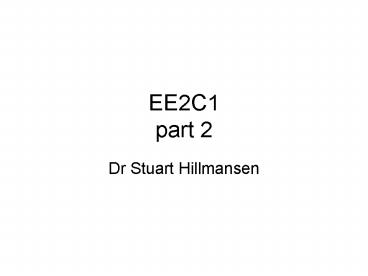EE2C1 part 2 - PowerPoint PPT Presentation
1 / 44
Title:
EE2C1 part 2
Description:
... as if they are on the stator side gives. Induction motor equivalent circuit. R1, X1 = stator resistance & reactance. R2, X2 = rotor resistance & reactance ... – PowerPoint PPT presentation
Number of Views:52
Avg rating:3.0/5.0
Title: EE2C1 part 2
1
EE2C1part 2
- Dr Stuart Hillmansen
2
Summary of where we are
- Lab Thursday Xth of November
- Must attend and hand in lab report week 1 of
semester 2, Tuesday 1200. Room 521/522. 10 of
Module mark - Tutorial on the Xth of December (will give out
tutorial sheet soon) - 6 more lectures
- Rotating machines
- Induction
- DC
- Permanent magnet brushless DC
- Power distribution systems
- Time for a recap if possible
3
(No Transcript)
4
(No Transcript)
5
How can we produce a torque from a magnetic field?
6
(No Transcript)
7
(No Transcript)
8
(No Transcript)
9
(No Transcript)
10
(No Transcript)
11
(No Transcript)
12
Flux in the air gap becomes
13
Finally
14
3-Phase Supply System
15
(No Transcript)
16
(No Transcript)
17
Industrial AC Machine Stator
Induction motor stator with double-layer winding,
partly wound
18
Squirrel cage induction rotor
19
Squirrel-Cage Rotor
Cage-type rotor in part section showing cast
aluminium bars and end-ring
20
Define Slip
- Slip s (?s-?r)/?s
- where ?s ?/p
- ?s synchronous speed
- ?r rotor speed
- ? supply angular frequency
- p pole pairs
21
Interaction of Stator Rotor Fields
- Rotor currents gt s?
- Rotor currents produce mmf
- Rotor field gt s? with respect to rotor
- Rotor itself rotates at (1-s)?
- Rotor field gt Sync. speed
- Steady torque produced is
- T ? FrFssin ? or
- T ? FrFscos ?
Fig. 6 Simplified AC machine winding layout
22
Equivalent Circuit
- The induction motor is like a transformer with a
rotating secondary - Max induced rotor voltage is at standstill
- Min induced rotor voltage is at sync. Speed
- Air-gap flux must be constant for constant supply
voltage.
23
Let V2 max induced rotor voltage
where X2 ?L2 standstill rotor
reactance Scaling quantities as if they are on
the stator side gives
R1, X1 stator resistance reactance R2, X2
rotor resistance reactance R0, Xm core loss
magnetising reactance
Induction motor equivalent circuit
24
- For simplicity, an approximation where Xm R0
are moved to the input terminal is often used for
normal operation - The term is split into
- represents copper loss
- represents the
mechanical output power - Thus,
- Or
25
Torque vs. Speed Characteristics
- Ignoring the stator impedance for a reasonable
view - where m number of phases.
26
General shape of induction motor torque/speed
curve
27
Notes
- At small slip (s), s2 is vanishingly small so
that - torque varies linearly with s and reducing R2
increases the torque - There is a distinct maximum or pull-out torque
when - Practical values of slip are 1-5 with pull-out
around 10-12, otherwise machine is inefficient - THUS, INDUCTION MOTOR IS BASICALLY CONSTANT SPEED
FOR FIXED ?.
28
DC Machine Construction 1
Commutator, isolated copper sections, on which
carbon brushes bear
Core formed from laminations
b) Schematic Cross-Section
a) DC Machine Armature
29
3. Primitive DC Machine
Current in pivoted coil will set up a field which
will try to align itself with the stationary
field thus producing torque If many coils each
at small angle to the next are arranged to be fed
with current through a synchronised mechanical
switch such that they together form a field at
right angles to the stationary field then
continuous torque production and rotation is
produced
30
Basic Characteristics 1
- Induced voltage in an armature rotating at fixed
speed (E) ? flux (?), below saturation level - The induced voltage is directly proportional to
speed (E ??) - Thus, for operation below saturation level
- E k?? k?If
- where ? ? If (field current)
- k, k are arbitrary constants
- ? is the flux per pole
- ? is the machine speed.
31
Symbolic DC Machine Representation
- Field circuit If Vf/Rf
- Armature circuit Va E IaRa
- Lastly, interaction of Ia and ? produces torque
- T kIa? or T kIaIf (linear magnetisation)
32
Methods of Excitation
- There are three basic excitation methods
- i) Series, ii) Shunt and iii) Separate
a) Series b) Shunt
c) Separate
33
Torque vs. Speed for the DC Machine
Series
Shunt or Separate
34
Permanent Magnet Brushless DC Machine
35
(No Transcript)
36
(No Transcript)
37
(No Transcript)
38
(No Transcript)
39
Power systems
40
(No Transcript)
41
(No Transcript)
42
(No Transcript)
43
To calculate power flow
44
(No Transcript)































